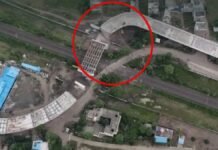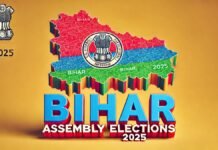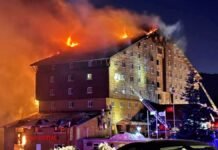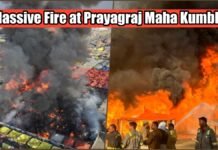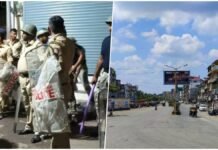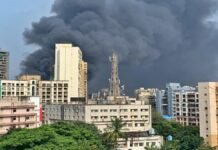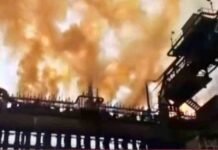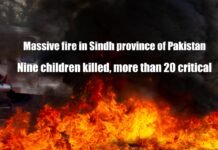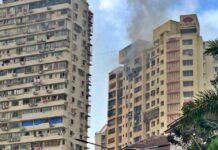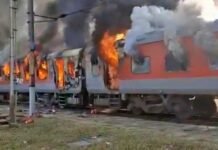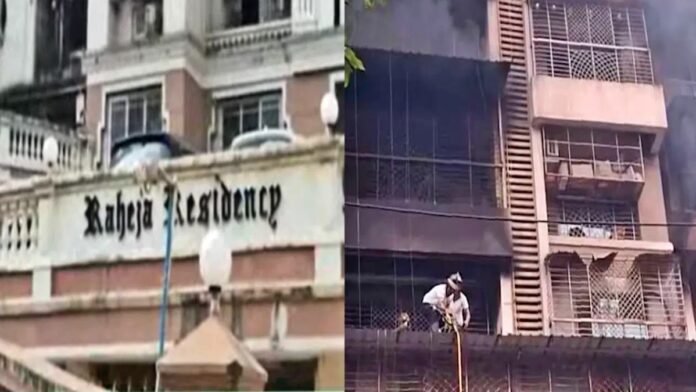
Key Points
- Massive fire erupts at Raheja Residency building in Sector 14, Navi Mumbai at 12:30 AM on October 21, 2025
- Four people killed: two women, one man, and a six-year-old girl; 10 others suffer serious burns
- Fire originates on 10th floor, rapidly spreads to 11th and 12th floors of multi-story residential complex
- Fire brigade brings blaze under control after 3.5-hour operation ending at 4:00 AM
- Injured victims receiving treatment at Fortis Hospital; some discharged, others in critical care
- Cause of fire remains undetermined; police launch detailed investigation
- Incident highlights fire safety concerns in high-rise residential buildings across Mumbai metropolitan region
Navi Mumbai: A devastating fire ripped through a high-rise residential building in Navi Mumbai during the early hours of October 21, 2025, claiming four lives including a six-year-old girl and leaving 10 others with severe burn injuries. The tragedy at Raheja Residency in Sector 14 has once again raised serious questions about fire safety protocols in multi-story residential complexes across the Mumbai metropolitan region.
Midnight Inferno
The fire erupted around 12:30 AM on Tuesday, shattering the silence of the night and sending residents of Raheja Residency into panic. Initial reports indicate the blaze originated on the 10th floor of the multi-story structure before rapidly spreading vertically to engulf the 11th and 12th floors.
Witnesses described scenes of chaos as flames shot out of windows and thick smoke billowed into the night sky, visible from considerable distances across Navi Mumbai. The speed with which the fire spread suggests the presence of combustible materials and possible lapses in fire containment systems within the building.
Residents awakened by smoke alarms and neighbors’ shouts scrambled to evacuate, with many forced to navigate smoke-filled corridors and stairwells in darkness. The vertical spread pattern indicates that the fire likely traveled through utility shafts, ventilation systems, or external facades common pathways in high-rise fire incidents.
Victims and Casualties
Vashi Division Assistant Commissioner of Police (ACP) Adinath Raghunath Budhwant confirmed that 14 people were directly affected by the fire, with four succumbing to their injuries. The deceased include two adult women, one adult male, and a six-year-old girl, representing a tragic cross-section of ages caught in the inferno.
The inclusion of a young child among the fatalities has intensified public grief and anger over the incident. Children are particularly vulnerable in fire emergencies due to their limited mobility, understanding of danger, and dependency on adult rescuers.
Authorities have not yet released the identities of the deceased pending family notifications, though police sources indicate all four victims resided in the affected floors of Raheja Residency. The exact circumstances of how each victim became trapped or overcome by flames and smoke remain under investigation.
The fatality count could have been significantly higher given the time of night when most residents were asleep and the fire’s rapid progression through multiple floors. That the death toll remained limited to four speaks to both luck and the rapid response of residents and emergency services.
Injured Receiving Treatment
Ten individuals who suffered serious burn injuries were rushed to Fortis Hospital in Vashi immediately following the fire. The injured represent a range of burn severities, with medical staff working through the night and into Tuesday morning to stabilize patients and treat thermal injuries.
Burn injuries present complex medical challenges requiring specialized treatment including fluid resuscitation, infection prevention, pain management, and often multiple surgical interventions. The severity of burns determines long-term prognosis, with third-degree burns requiring extensive skin grafting and rehabilitation.
As of Tuesday afternoon, hospital sources confirmed that some patients with relatively minor burns have been treated and discharged. However, several victims remain hospitalized in critical or serious condition, requiring ongoing intensive care. Medical staff have indicated that the next 48-72 hours will be crucial in determining outcomes for the most severely injured patients.
Families of the injured have gathered at Fortis Hospital, many still in shock from the sudden tragedy. Hospital administration has arranged counseling services and support for affected families dealing with the trauma of the incident.
Emergency Response Operation
Fire brigade teams from multiple stations responded immediately upon receiving distress calls around 12:30 AM. The Navi Mumbai Fire Department dispatched several fire tenders, water tankers, and specialized equipment to the scene within minutes of the initial alert.
Firefighters faced significant challenges in combating the blaze in a high-rise structure. Accessing upper floors, establishing water supply to elevated levels, and conducting search and rescue operations in smoke-filled environments required coordinated tactical operations.
Fire brigade personnel deployed aerial ladders and conducted systematic floor-by-floor searches to locate and evacuate trapped residents. Breathing apparatus equipment allowed firefighters to enter smoke-filled apartments and corridors where visibility was reduced to near zero.
After approximately 3.5 hours of intensive firefighting operations, crews brought the blaze under control at 4:00 AM. The prolonged duration indicates the fire’s intensity and the challenges posed by the building’s height and construction materials.
Cooling operations continued for several hours after the fire was declared under control to prevent rekindling. Fire investigators arrived at daybreak to begin examining the scene, documenting damage patterns, and collecting evidence to determine the fire’s origin and cause.
Building and Safety Context
Raheja Residency is part of the larger residential development landscape in Sector 14, Navi Mumbai—an area that has seen significant high-rise construction over the past decade. The building houses dozens of families across its multiple floors, representing a densely populated vertical community.
Initial questions have emerged about the building’s fire safety infrastructure, including the functionality of fire alarms, sprinkler systems, smoke detectors, fire extinguishers, and emergency exits. Investigators will examine whether all required safety equipment was present, properly maintained, and operational at the time of the fire.
Building regulations mandate specific fire safety measures for high-rise residential structures, including fire-resistant construction materials, dedicated firefighting equipment, clear evacuation routes, and regular safety drills. Compliance verification will be a key aspect of the investigation.
Residents of neighboring buildings in the complex expressed concerns about fire safety preparedness, with many acknowledging they have never participated in fire drills and are unclear about evacuation procedures. This lack of preparedness is common across residential complexes throughout the Mumbai metropolitan region.
Investigation Underway
Navi Mumbai Police have launched a comprehensive investigation into the incident, though as of Tuesday afternoon, the exact cause of the fire remains undetermined. Multiple factors are being examined, including electrical short circuits, gas leaks, cooking accidents, and the possibility of human negligence.
Forensic teams are conducting detailed examinations of the 10th floor apartment where the fire reportedly originated. Physical evidence including burn patterns, electrical wiring, gas connections, and any ignition sources will be analyzed to reconstruct the fire’s inception.
Police are recording statements from survivors, witnesses, and building management staff to piece together a timeline of events. Security camera footage from the building and surrounding area is being reviewed to identify any suspicious activity or circumstances preceding the fire.
The investigation will also examine whether building management fulfilled legal obligations regarding fire safety equipment maintenance, emergency planning, and resident awareness programs. Negligence findings could result in criminal charges against responsible parties.
Building department officials are conducting structural safety assessments to determine if fire damage has compromised the building’s integrity. Residents of affected floors and potentially adjacent areas may face temporary displacement pending safety clearances.
Recurring Fire Safety Concerns
This tragic incident represents the latest in a series of fire emergencies affecting high-rise residential buildings across the Mumbai metropolitan region in recent years. Despite regulatory frameworks and safety requirements, implementation gaps and enforcement challenges continue putting residents at risk.
Common fire safety lapses identified in previous incidents include non-functional fire alarms, blocked emergency exits, inadequate firefighting equipment, poor maintenance of electrical systems, and absence of resident preparedness training. Many older buildings lack modern fire suppression systems, while even newer constructions sometimes fail to maintain installed equipment properly.
Fire department officials have repeatedly emphasized the need for regular fire safety audits, mandatory resident training, and strict enforcement of building code compliance. However, resource constraints and the sheer volume of residential structures make comprehensive oversight challenging.
Urban planners note that the rapid vertical expansion of cities like Mumbai and Navi Mumbai has outpaced development of adequate emergency response infrastructure. Fire stations, equipment, and personnel often struggle to keep pace with the growing number and height of residential towers.
Community Response and Support
Local authorities have announced compensation for families of the deceased, though monetary support can never truly address the loss of loved ones. Community organizations and resident welfare associations are coordinating support for affected families, including assistance with medical expenses and temporary accommodation arrangements.
Mental health professionals have highlighted the psychological trauma experienced not only by direct victims but also by witnesses and residents who escaped the fire. Community counseling programs are being organized to help residents process the traumatic experience and address ongoing anxiety about safety.
Neighboring residential complexes have announced plans to conduct fire safety audits and resident awareness programs in response to the tragedy. The incident has served as a wake-up call for many residents who previously viewed fire preparedness as abstract rather than urgent.
Policy and Prevention Implications
Housing activists and safety experts are calling for stricter enforcement of fire safety regulations, mandatory third-party safety audits for all high-rise residential buildings, and criminal accountability for negligence leading to fire fatalities.
Recommendations include requiring residential buildings to install modern fire suppression systems, conduct quarterly fire drills, maintain detailed evacuation plans, and provide fire safety training to all residents and staff. Digital monitoring systems that automatically alert fire departments when alarms are triggered could reduce response times.
Building design standards may need updates to incorporate lessons learned from fire incidents, including requirements for fire-resistant materials, multiple evacuation routes, pressurized stairwells preventing smoke infiltration, and refuge areas on upper floors.
Ultimately, preventing future tragedies requires a comprehensive approach combining regulatory enforcement, building owner accountability, resident awareness, and adequate emergency response infrastructure. The lives lost at Raheja Residency demand nothing less than systemic reforms to protect the millions of people living in high-rise residential buildings across India’s rapidly urbanizing landscape.
As Navi Mumbai mourns the victims of this devastating fire, the incident serves as a sobering reminder that fire safety cannot be treated as an afterthought in our vertical cities. Every resident deserves the assurance that their home meets basic safety standards and that help will arrive quickly should disaster strike.
Key Points
- Delhi’s average AQI reaches 345 (‘very poor’ category) on Diwali day, up from 326 on Sunday
- 34 out of 38 monitoring stations record pollution in ‘red zone’ as of 4 PM on October 21, 2025
- Four stations enter ‘severe’ category with AQI above 400: Wazirpur (423), Dwarka (417), Ashok Vihar (404), Anand Vihar (404)
- Transportation contributes 15.6% to pollution; industrial and other sources account for 23.3%
- Air quality forecast to worsen to ‘severe’ category on Tuesday and Wednesday
- CAQM implements GRAP Stage-2 restrictions across Delhi-NCR
- Supreme Court permitted green crackers from 8-10 PM on Diwali despite air quality concerns
The national capital woke up to hazardous air on Diwali morning, October 21, 2025, as pollution levels surged across the city despite restrictions on conventional firecrackers. By 4 PM, Delhi’s 24-hour average Air Quality Index (AQI) climbed to 345, firmly in the ‘very poor’ category, marking a deterioration from Sunday’s reading of 326 and confirming predictions of post-festival air quality crisis.
Widespread Pollution Across Monitoring Network
Real-time data from the Central Pollution Control Board (CPCB)’s Sameer app painted a grim picture of Delhi’s air quality landscape. Of the 38 functional monitoring stations spread across the capital, 34 stations recorded pollution levels in the dangerous ‘red zone,’ indicating ‘very poor’ to ‘severe’ air quality conditions affecting millions of residents.
The geographic spread of poor air quality demonstrates that no area of Delhi escaped the pollution surge. From residential neighborhoods to commercial hubs, the toxic air blanketed the entire city, with visibility reduced and a thick haze hanging over major thoroughfares.
Four Stations Enter ‘Severe’ Territory
Most alarming were readings from four monitoring stations that crossed into the ‘severe’ category with AQI levels exceeding 400. Wazirpur in north Delhi recorded the highest AQI at 423, followed by Dwarka in southwest Delhi at 417. Both Ashok Vihar in northwest Delhi and Anand Vihar in east Delhi registered AQI of 404.
These ‘severe’ category readings indicate air quality so poor that it affects healthy people and seriously impacts those with existing respiratory conditions. Health advisories typically recommend that residents avoid all outdoor physical activity when AQI enters this range.
The concentration of severely polluted stations in diverse geographical areas from industrial Wazirpur to residential Dwarka suggests multiple pollution sources contributing simultaneously to the crisis rather than localized factors.
Thirty Stations Report ‘Very Poor’ Air
Nearly 30 monitoring stations across Delhi reported AQI in the ‘very poor’ category, with readings above 300 but below the 400 threshold for ‘severe’ classification. This category indicates that prolonged exposure can cause respiratory illness in the general population and aggravate existing heart and lung diseases.
Data collected at noon showed 31 out of 38 stations recording ‘very poor’ air quality, while three had already entered the ‘severe’ category. The afternoon progression demonstrates how pollution accumulated throughout the day as festival activities intensified.
Areas reporting ‘very poor’ air quality included major residential zones, commercial districts, and institutional areas, confirming the citywide nature of the pollution emergency. No monitoring station recorded air quality better than the ‘poor’ category on Diwali day.
Understanding the AQI Scale
The Air Quality Index operates on a standardized scale that categorizes pollution levels:
- 0-50: Good (minimal health impact)
- 51-100: Satisfactory (minor breathing discomfort for sensitive individuals)
- 101-200: Moderate (breathing discomfort for people with lung disease)
- 201-300: Poor (breathing discomfort for most people on prolonged exposure)
- 301-400: Very Poor (respiratory illness on prolonged exposure)
- 401-500: Severe (affects healthy people; serious impact on those with existing diseases)
Delhi’s current readings place most of the city in the second-worst category, with pockets entering the worst classification. These levels pose serious health risks, particularly for children, elderly residents, and those with pre-existing cardiovascular or respiratory conditions.
Forecast: Worsening Conditions Ahead
Environmental agencies issued alerts warning that Delhi’s air quality is expected to deteriorate further, potentially reaching the ‘severe’ category across most monitoring stations on Tuesday, October 22, and Wednesday, October 23. This grim forecast accounts for several factors including meteorological conditions, continued burning of firecrackers in NCR areas, and residual pollutants settling in the atmosphere.
The predicted worsening comes despite firecracker restrictions, suggesting that other pollution sources—including vehicular emissions, industrial activity, and seasonal factors like stubble burning in neighboring states—continue contributing significantly to the toxic air mix.
Meteorologists note that reduced wind speeds and lower temperatures typical of late October create unfavorable dispersion conditions, trapping pollutants close to ground level and preventing natural cleansing of the air.
Pollution Source Analysis
Decision Support System (DSS) data provided detailed attribution of pollution sources contributing to Delhi’s toxic air on Diwali. Transportation emissions accounted for 15.6% of the total pollution load, reflecting continued vehicular traffic despite festival holidays when some commuter traffic typically decreases.
More significantly, industries and other sources contributed 23.3% to air pollution levels. This substantial contribution from non-firecracker sources explains why pollution levels remained elevated even before evening festivities began and suggests that addressing Delhi’s air quality crisis requires comprehensive interventions beyond seasonal firecracker bans.
The remaining pollution sources include construction dust, biomass burning, waste burning, and regional pollutants transported from neighboring states. The cumulative effect of these multiple sources creates the toxic air blanket enveloping the capital.
GRAP Stage-2 Restrictions Implemented
In anticipation of deteriorating air quality, the Commission for Air Quality Management (CAQM) implemented Stage-2 restrictions under the Graded Response Action Plan (GRAP) across the Delhi-NCR region before Diwali. These intermediate-level restrictions aim to curb pollution through targeted interventions.
GRAP Stage-2 measures include:
- Enhanced mechanical and vacuum sweeping of roads
- Water sprinkling on major traffic corridors
- Strict enforcement against garbage and biomass burning
- Intensified inspections at pollution hotspots
- Enhanced parking fees to discourage private vehicle use
- Increased public transport services
- Restrictions on diesel generator use except for emergency services
Despite these measures, pollution levels continued rising, raising questions about enforcement effectiveness and the adequacy of current intervention strategies. Environmental activists argue that more aggressive actions, including temporary industrial shutdowns and emergency vehicle restrictions, may be necessary when air quality enters ‘severe’ territory.
Supreme Court’s Green Cracker Permission
The Supreme Court of India issued an order on October 15, 2025, permitting the sale and use of so-called “green crackers” in Delhi-NCR, subject to specific time restrictions. This ruling attempted to balance cultural traditions associated with Diwali celebrations against public health concerns related to air pollution.
Under the court’s directive, bursting of green crackers was permitted during two time windows:
- 6:00 AM to 7:00 PM on the day before Diwali and on Diwali day
- 8:00 PM to 10:00 PM on Diwali night
Green crackers, developed by the Council of Scientific and Industrial Research (CSIR), are designed to produce 30% less particulate matter compared to conventional firecrackers and eliminate certain toxic chemicals. However, their real-world effectiveness remains debated, with environmental groups questioning whether meaningful reductions in pollution occur.
The court’s decision represented a compromise position after years of complete firecracker bans that proved difficult to enforce and generated significant public resistance. Critics argue that any firecracker burning contributes to pollution spikes, while supporters maintain that limited, regulated use of reduced-emission alternatives respects cultural practices while minimizing environmental harm.
Ground Reality: Enforcement Challenges
Despite the restricted time windows and specifications for only green crackers, ground reports suggest widespread violations occurred across Delhi-NCR. Conventional firecrackers were openly sold and burst throughout the region, with enforcement agencies overwhelmed by the scale of non-compliance.
Police and pollution control board officials reported numerous complaints about illegal firecracker use outside permitted hours and sale of banned conventional crackers. However, limited personnel and the distributed nature of violations made comprehensive enforcement practically impossible.
The widespread flouting of restrictions contributed to the severe pollution spike, though environmental experts note that even perfect compliance would not have prevented significant air quality deterioration given Delhi’s baseline pollution levels and unfavorable meteorological conditions.
Public Health Implications
The toxic air quality poses immediate and long-term health risks for Delhi’s 20+ million residents. Short-term exposure to ‘very poor’ and ‘severe’ air quality causes respiratory irritation, breathing difficulties, coughing, and aggravation of asthma and other lung diseases.
Vulnerable populations including children, pregnant women, elderly residents, and those with cardiovascular or respiratory conditions face particularly high risks. Doctors across Delhi reported increased emergency room visits for breathing difficulties and asthma attacks following Diwali evening.
Long-term exposure to such pollution levels contributes to chronic respiratory diseases, cardiovascular problems, reduced lung function in children, and increased cancer risks. Studies have shown that Delhi residents lose years of life expectancy due to sustained exposure to hazardous air quality.
Comparative Context
Delhi’s Diwali pollution crisis has become an annual occurrence, with similar patterns observed in recent years. However, the 2025 readings represent a continuation of concerning trends despite various policy interventions attempted over the past decade.
Compared to previous years, enforcement of firecracker restrictions has improved marginally, but behavioral change among the population remains limited. The cultural significance of fireworks during Diwali creates resistance to restrictions, while lack of immediate visible health consequences reduces urgency for voluntary compliance.
Regional cooperation on pollution control remains inadequate, with neighboring states’ contributions through stubble burning and industrial emissions continuing unchecked. The National Capital Region’s air quality management requires coordinated action across state boundaries that has proven politically and administratively challenging to implement.
Looking Ahead
As Delhi braces for continued poor air quality through the coming days, authorities face pressure to implement more aggressive interventions under higher GRAP stages. Stage-3 and Stage-4 measures include construction bans, school closures, work-from-home mandates, and restrictions on private vehicle use.
The recurring nature of Delhi’s air quality crisis highlights the need for year-round pollution control measures rather than seasonal emergency responses. Systemic changes in transportation, energy, construction practices, and waste management are necessary to address the structural causes of poor air quality.

















